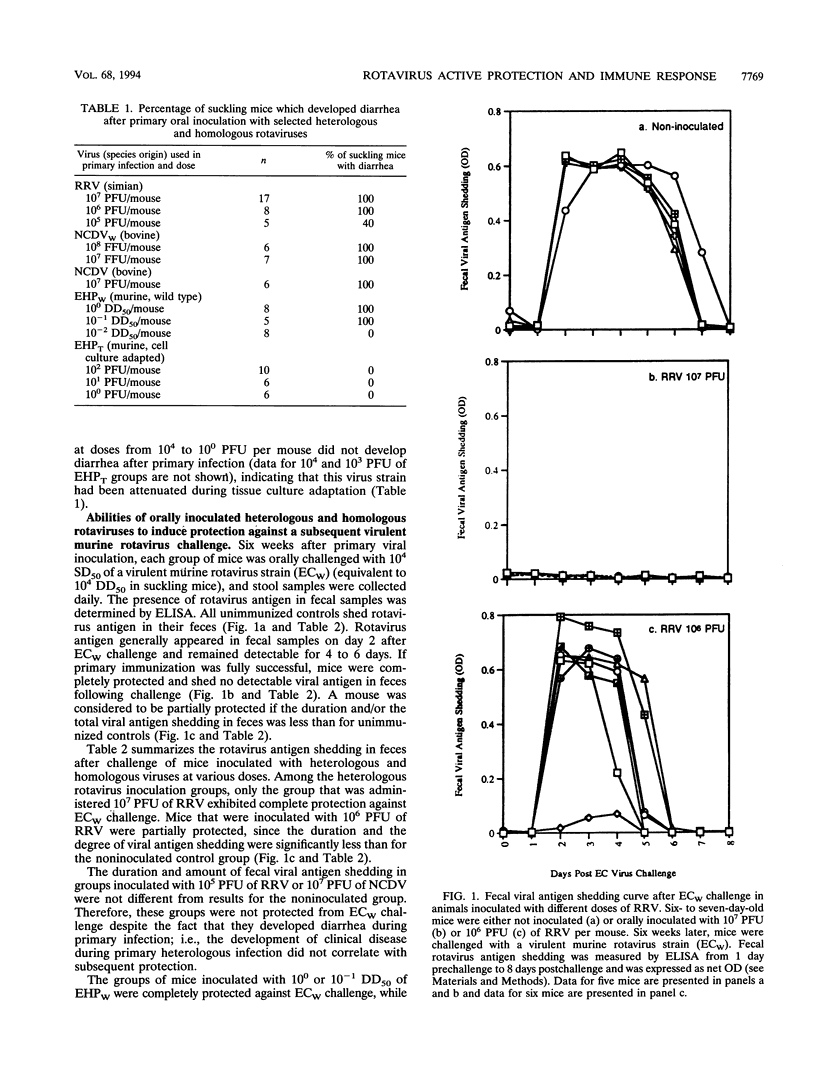Abstract
Rotaviruses are the single most important cause of severe diarrhea in young children worldwide, and vaccination is probably the most effective way to control the disease. Most current live virus vaccine candidates are based on the host range-restricted attenuation of heterologous animal rotaviruses in humans. The protective efficacy of these vaccine candidates has been variable. To better understand the nature of the heterologous rotavirus-induced active immune response, we compared the differences in the mucosal and systemic immune responses generated by heterologous (nonmurine) and homologous (murine) rotaviruses as well as the ability of these infections to produce subsequent protective immunity in a mouse model. Sucking mice were orally inoculated with a heterologous simian or bovine rotavirus (strain RRV or NCDV) or a homologous murine rotavirus (wild-type or tissue culture-adapted) strain EHP at various doses. Six weeks later, mice were challenged with a virulent murine rotavirus (wild-type strain ECW) and the shedding of viral antigen in feces was quantitated. Levels of rotavirus-specific serum immunoglobulin G (IgG) and fecal IgA prior to challenge were measured and correlated with subsequent viral shedding or protection. Heterologous rotavirus-induced active protection was highly dependent on the strain and dose of the virus tested. Mice inoculated with a high dose (10(7) PFU per mouse) of RRV were completely protected, while the protection was diminished in animals inoculated with NCDV or lower doses of RRV. The ability of a heterologous rotavirus to stimulate a detectable intestinal IgA response correlated with the ability of the virus to generate protective immunity. Serum IgG titer did not correlate with protection. Homologous rotavirus infection, on the other hand, was much more efficient at inducing both mucosal and systemic immune responses as well as protection regardless of the virulence of the virus strain or the size of the immunizing dose.
Full text
PDF







Selected References
These references are in PubMed. This may not be the complete list of references from this article.
- Bishop R. F. Development of candidate rotavirus vaccines. Vaccine. 1993;11(2):247–254. doi: 10.1016/0264-410x(93)90025-s. [DOI] [PubMed] [Google Scholar]
- Broome R. L., Vo P. T., Ward R. L., Clark H. F., Greenberg H. B. Murine rotavirus genes encoding outer capsid proteins VP4 and VP7 are not major determinants of host range restriction and virulence. J Virol. 1993 May;67(5):2448–2455. doi: 10.1128/jvi.67.5.2448-2455.1993. [DOI] [PMC free article] [PubMed] [Google Scholar]
- Dunn S. J., Burns J. W., Cross T. L., Vo P. T., Ward R. L., Bremont M., Greenberg H. B. Comparison of VP4 and VP7 of five murine rotavirus strains. Virology. 1994 Sep;203(2):250–259. doi: 10.1006/viro.1994.1482. [DOI] [PubMed] [Google Scholar]
- Flores J., Perez-Schael I., Blanco M., Rojas A. M., Alfonzo E., Crespo I., Cunto W., Pittman A. L., Kapikian A. Z. Reactogenicity and immunogenicity of a high-titer rhesus rotavirus-based quadrivalent rotavirus vaccine. J Clin Microbiol. 1993 Sep;31(9):2439–2445. doi: 10.1128/jcm.31.9.2439-2445.1993. [DOI] [PMC free article] [PubMed] [Google Scholar]
- Greenberg H. B., Vo P. T., Jones R. Cultivation and characterization of three strains of murine rotavirus. J Virol. 1986 Feb;57(2):585–590. doi: 10.1128/jvi.57.2.585-590.1986. [DOI] [PMC free article] [PubMed] [Google Scholar]
- Ho M. S., Glass R. I., Pinsky P. F., Anderson L. J. Rotavirus as a cause of diarrheal morbidity and mortality in the United States. J Infect Dis. 1988 Nov;158(5):1112–1116. doi: 10.1093/infdis/158.5.1112. [DOI] [PubMed] [Google Scholar]
- Ho M. S., Glass R. I., Pinsky P. F., Young-Okoh N. C., Sappenfield W. M., Buehler J. W., Gunter N., Anderson L. J. Diarrheal deaths in American children. Are they preventable? JAMA. 1988 Dec 9;260(22):3281–3285. [PubMed] [Google Scholar]
- Hoshino Y., Wyatt R. G., Greenberg H. B., Flores J., Kapikian A. Z. Serotypic similarity and diversity of rotaviruses of mammalian and avian origin as studied by plaque-reduction neutralization. J Infect Dis. 1984 May;149(5):694–702. doi: 10.1093/infdis/149.5.694. [DOI] [PubMed] [Google Scholar]
- Kapikian A. Z., Vesikari T., Ruuska T., Madore H. P., Christy C., Dolin R., Flores J., Green K. Y., Davidson B. L., Gorziglia M. An update on the "Jennerian" and modified "Jennerian" approach to vaccination of infants and young children against rotavirus diarrhea. Adv Exp Med Biol. 1992;327:59–69. doi: 10.1007/978-1-4615-3410-5_8. [DOI] [PubMed] [Google Scholar]
- Matson D. O., O'Ryan M. L., Herrera I., Pickering L. K., Estes M. K. Fecal antibody responses to symptomatic and asymptomatic rotavirus infections. J Infect Dis. 1993 Mar;167(3):577–583. doi: 10.1093/infdis/167.3.577. [DOI] [PubMed] [Google Scholar]
- Midthun K., Greenberg H. B., Hoshino Y., Kapikian A. Z., Wyatt R. G., Chanock R. M. Reassortant rotaviruses as potential live rotavirus vaccine candidates. J Virol. 1985 Mar;53(3):949–954. doi: 10.1128/jvi.53.3.949-954.1985. [DOI] [PMC free article] [PubMed] [Google Scholar]
- Midthun K., Hoshino Y., Kapikian A. Z., Chanock R. M. Single gene substitution rotavirus reassortants containing the major neutralization protein (VP7) of human rotavirus serotype 4. J Clin Microbiol. 1986 Nov;24(5):822–826. doi: 10.1128/jcm.24.5.822-826.1986. [DOI] [PMC free article] [PubMed] [Google Scholar]
- Vesikari T. Clinical trials of live oral rotavirus vaccines: the Finnish experience. Vaccine. 1993;11(2):255–261. doi: 10.1016/0264-410x(93)90026-t. [DOI] [PubMed] [Google Scholar]
- Ward R. L., McNeal M. M., Sheridan J. F. Development of an adult mouse model for studies on protection against rotavirus. J Virol. 1990 Oct;64(10):5070–5075. doi: 10.1128/jvi.64.10.5070-5075.1990. [DOI] [PMC free article] [PubMed] [Google Scholar]


